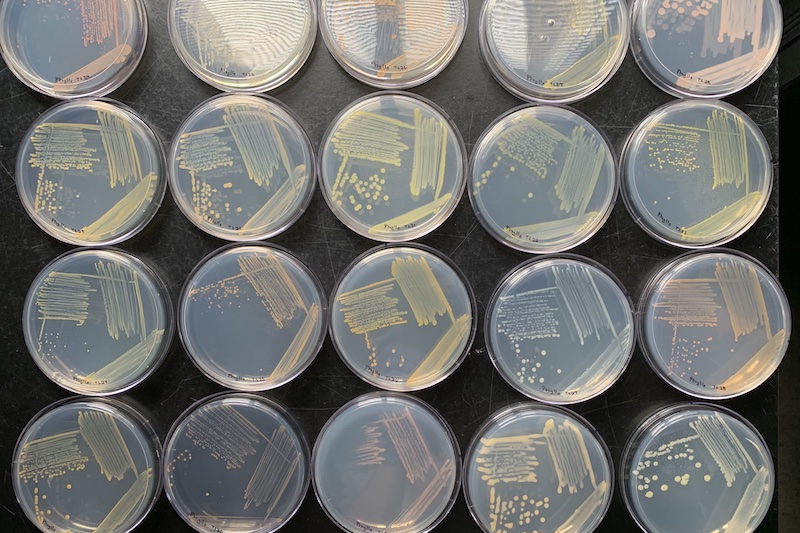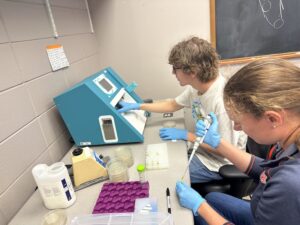
19 Apr Managing a small research collection – An insider view
By Neha Potnis
Associate Professor
Department of Entomology and Plant Pathology
Auburn University, AL, USA
I began my research program at Auburn University in the Department of Entomology and Plant Pathology six years ago. In this short timeframe, we have already built a small collection of bacterial and fungal isolates, pathogens and commensals, from various hosts and Alabama locations. These isolates have been collected from leaves, roots and fruits of tomato, peppers and cucurbits sampled at farmer’s markets, greenhouses, from grower’s fields and from community gardens.
In my research program, we study host-microbe-environment interactions with the aim to identify the factors that influence plant susceptibility to pathogens. My research group uses our isolate collection for various projects such as, (a) understanding the factors involved in disease emergence by characterizing isolates using pathogenicity assays, genome sequencing and population genomics approaches and association analyses, (b) investigating the mechanistic basis for lifestyles of plant associated organisms, such as what makes a microbe generalist – colonizing a broad range of plants – or specialist – infecting only certain hosts, (c) dissecting the interactions between pathogens and resident microbes, and (d) designing synthetic microbial communities to investigate the role of the microbiota in plant tolerance to biotic or abiotic stresses.
Long-term maintenance
Over the past few years, as we advance in these projects, we have been striving to improve our approaches to keep a systematic record of our collection and a backup culture stocks. I have found guidelines from the World Federation for Culture Collections to be useful to follow. I am lucky to have passionate students and research associates who contribute significantly to the effort of building this collection. However, I am also concerned about the long-term maintenance of our research collection.
Dedicated personnel in small research labs like mine are essential to not only maintain the collection, but to also keep detailed phenotypic records to accurately identify the isolates, assess risk groups and identify associated biosecurity risks. The taxonomic identity system using genome sequence-based tools, such as LINbase, would be highly useful to classify the isolates for risk assessment, and to ensure their safe use in greenhouse or field experiments. However, this requires dedicated funding, which we do not have at the moment.
Standards and protocols

Students working on experiments on tomato using synthetic community
Credit: Potnis lab, Auburn University
In recent years, my research took some new directions. We began looking beyond binary plant-pathogen interactions and started exploring multipartite interactions among plant-pathogen-microbiota and the environment. While we have gathered culture-independent data on the microbial community successfully, culture-dependent approaches have been challenging.
We experimented with different approaches to preserve the majority of the culturable members of the microbiota associated with plant samples. We tried different media for isolating the different members of the community, saving the pools of these microbes in glycerol stocks. We have also used high-throughput culturing platform.
This helped us build a massive collection of isolates in pure culture from plant samples, speeding up the efforts to obtain community members in pure culture. We have collected thousands of isolates from tomato leaf samples alone. However, a significant bottleneck of this approach is the downstream analysis to identify their taxonomic entities, to characterize their plant-associated phenotypes, and finally their maintenance.
In parallel, we froze the leaf washings in glycerol stocks in attempts to preserve microbial communities associated with samples collected across space and time. I believe this is one area where we need to develop uniform methods and protocols for preserving the microbiota without significantly altering the community structure. We could then use those preserved communities for downstream experiments to dissect microbial interactions, associate the traits imparted by these communities, and build synthetic communities.
Sharing platform
As a plant pathology and microbiology lab, it is no surprise that we continue to build such collections as we conduct our research programs. There are small research collections in labs all over the world. Yet, compared to effective strategies for sharing sequencing data, our attempts to make research collections accessible to the scientific community are lagging.
This is where a network like USCCN is essential. It provides a strong platform for researchers to register their collections, to make them known to the community and to build potential collaborations. Early career researchers like me would greatly benefit from the resources provided by USCCN and the community connections built through this network.
I am looking forward to sharing our small collection with the plant health specialists around the world.
